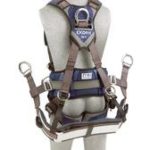The next SAFER meeting will be held Oct 3, 2018 from 8-10 am at the New England Institute of Technology, 2490 Post Road, Warwick, RI in the Hall of Fame room.
From Bob K: Team SAFER, we hope you enjoyed the last few weeks of summer! As we move into the last quarter of 2018, we should take stock of our work to complete and develop an executable plan to ensure that the work is completed safely, productively and with the quality expected by the owner.
Employers have an enormous amount of responsibility, perhaps the greatest, is the assessment of qualification, training and delegation of authority to supervisors. But wait….
What is a supervisor and what is their role in safety?
To answer the second part of the question, we have invited Joe Werbicki to present “The Supervisor’s Role in Safety” – here are a few keys points:
– People do what is expected of them. It is the Supervisor’s job to set the standards.
– The role of a supervisor is critical in engaging the workforce in safety
– Safety is everyone’s job, not just the safety staff
– People deserve to know the hazards of their jobs before they can perform the job
safely
As for the definition, I can only provide resources to support your quest for information, as follows:
For a copy of the 29 CFR part 1926 published in 2017 – see this link: https://www.gpo.gov/fdsys/granule/CFR-2017-title29-vol8/CFR-2017-title29-vol8-part1926 . When you open the page scroll down to yellow highlighted section. Open the .pdf document and search for supervisor. It appears 57 times……do you have a better understanding?
The Occupational Safety and Health Review Commission (OSHRC) provides the following definitions:
The Commission [OSHRC] has long recognized that “an employee who has been delegated authority over other employees, even if only temporarily, is considered to be a supervisor” for the purpose of establishing knowledge. Access Equip. Sys., 18 BNA OSHC at 1726, 1999 CCH OSHD at p. 46,782. In deciding whether an employee qualifies as a supervisor, “[i]t is the substance of the delegation of authority that is controlling, not the formal title of the employee having this authority.” Dover Elevator Co., 16 BNA OSHC 1281, 1286, 1993 CCH OSHD ¶ 30,148, p. 41,480 (No. 91-862, 1993).
In Daniel International Corp. v. OSHRC, 683 F.2d 361 (11th Cir. 1982), the court held, in considering a UEM defense, that an employee’s “position as leadman did not place him in a supervisory role,” such that his noncompliance with a safety rule suggested lax enforcement of such rules. 683 F.2d at 365. But Daniel is factually distinguishable from the present matter. Unlike Assistant General Superintendent Garcia’s actions here, the supervisor in Daniel did not delegate his authority to the “leadman” while he was away from the worksite, nor did the crew consider the leadman to be in charge. Rather, the supervisor in Daniel gave detailed instructions directly to the crew, personally oversaw the first part of the task he had assigned, and then remained onsite, sitting at a desk located only about ninety feet away from the work area. Id. at 362-63, 365. In these circumstances, we conclude that Eleventh Circuit precedent does not preclude us from imputing Coll-Gonzales’s knowledge here.
An employer is chargeable with knowledge of conditions which are plainly visible to its supervisory personnel. A.L. Baumgartner Construction Inc., 16 BNA OSHC 1995, 1998 (No. 92-1022, 1994). “Because corporate employers can only obtain knowledge through their agents, the actions and knowledge of supervisory personnel are generally imputed to their employers, and the Secretary can make a prima facie showing of knowledge by proving that a supervisory employee knew of or was responsible for the violation.” Todd Shipyards Corp., 11 BNA OSHC 2177, 2179 (No. 77-1598, 1984). See also Dun Par Engineered Form Co., 12 BNA OSHC 1962 (No. 82-928, 1986)(the actual or constructive knowledge of an employer’s foreman can be imputed to the employer).
An employee who has been delegated authority over another employee, even if only temporarily, is considered to be a supervisor for purposes of imputing knowledge to an employer. Tampa Shipyards, Inc., 15 BNA OSHC 1533 (Nos. 86-360 and 86-469, 1992).
Here are some information and standards that speak to employer responsibility:
https://www.osha.gov/as/opa/worker/employer-responsibility.html
https://www.osha.gov/laws-regs/regulations/standardnumber/1926/1926.20
https://www.osha.gov/laws-regs/regulations/standardnumber/1926/1926.21
And some additional resources:
OSHA Recommended Practices for safety and Health Programs –
https://www.osha.gov/shpguidelines/
Safety and the Supervisor-
https://osha.oregon.gov/edu/Documents/workshop-materials/1-160i.pdf
Hope to see you on the 3rd.
Regards,
